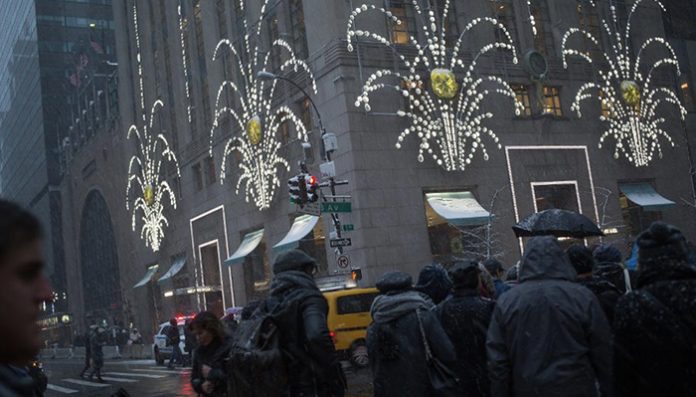The National Retail Federation is out with its typically optimistic prediction for the coming holiday season. This year the NRF expects retail sales during November and December to increase between 3.8% and 4.2% over the previous year. Sales are expected to reach somewhere in the neighborhood of $727.9 billion and $730.7 billion, excluding automobile dealers, gasoline stations and restaurants.
Is there any realistic hope that retail will hit that mark? Let’s look back at the 2018 holiday season when the NRF was calling for a 4.3% to 4.8% increase. When all was said and done, the retail market grew only 2.1% year-over-year, making holiday 2018 the slowest season since 2009.
In this year’s statement, NRF chief economist Jack Kleinhenz noted the difficulty in making predictions in what he termed an increasingly “uncertain macroeconomic environment.” Nonetheless, he put on his rose-colored glasses and came out with a forecast for strong growth this holiday season.
“There is significant economic unease, but current economic data and the recent momentum of the economy show that we can expect a much stronger holiday season than last year,” Kleinhenz said. “Job growth and higher wages mean there’s more money in families’ pockets, so we see both the willingness and ability to spend this holiday season.”
These annual NRF holiday predictions are getting to feel a bit like “Groundhog Day” and the forecasts resulting from it about as reliable as Punxsutawney Phil’s. That is why I called Paul Walsh, IBM’s global director of consumer weather and climate strategy, for the real holiday forecast.
Walsh explains that he is not an economist but that NRF’s economic model, which the release states is based upon employment data, wages, consumer confidence, disposable income, consumer credit and previous retail sales, may be underestimating an increasingly important factor affecting retail sales. That is the weather.
After posting, an NRF spokesperson provided a statement that Kleinhenz, a former president of the National Association of Business Economists, relies on a complex economic model. And while the release only states six indicators are included, his model “consists of well over a hundred, including weather.” The spokesperson also added Kleinhenz “does not make-up numbers to give a good spin for the retail industry.”
Shoppers respond to the weather
“Weather has a significant impact on our emotions and the way we feel which translates into retail sales,” Walsh told me. “When it gets cold, it flips the switch into thinking about holiday shopping. When it is 90 degrees in Atlanta in October, it doesn’t feel like its time to start buying things for winter.”
The weather will have a profound effect on both retailers’ topline and bottomline results this year, as it did last year. “Retailers have always known weather has a big impact on results. But what’s changed now is that because of our greater data assets and technology, we can integrate those insights into retailers’ enterprise resource planning (ERP) systems, so they have the right products in the stores at just the right time,” he continues.
What Walsh sees in the clouds for the holiday shopping season is an unseasonably warm October and November which will slow demand for winter and holiday season goods. It will be the exact opposite from last year when October and November were unseasonably cold. Since retailers traditionally use the previous year to model the next, retailers are likely to be overstocked in winter goods before consumers start shopping.
The risk then is for retailers to respond to markdown pressure early in the season, putting margins at risk. “By being too aggressive in markdowns early in the season, when demand finally kicks in December, they may well have given away too much margin early in the season,” he believes.
December’s colder weather can help drive positive comps from last year for seasonal apparel and hardlines, but that might skew spending away from non-seasonal gift items. Further, retailers’ December results may be mitigated by fewer shopping days this December compared to last year.
Retailers’ comps ignore the weather
The problem with predictions that don’t accurately factor in weather is that retail comps assume the weather will be the same year-over-year, which it rarely is.
“When retailers are able to integrate weather into their replenishment and markdown forecasts, they can predict what they will need where and when they will need it, so they have the right stock levels. With weather data added, the accuracy of those systems are increased by 20% to 25%. The benefits can be really significant,” he says, referring to a study that IBM conducted entitled “Just Add Weather.”
“Our rule of thumb is that a 1% increase in a demand forecast’s accuracy for a billion-dollar business can net out to about a $10 million benefit from improved in-stock positions and reduced mark downs,” Walsh says. “By adding weather into a demand forecast for seasonal product categories, we’ve seen companies increased forecast accuracy more than 20%.”
“This is what we call the ‘forecast factor’ and it is becoming super-critical for retailers to understand,” he continues. That is because both retailers and consumers have greater access to better and more predictable weather forecasts. “Everyone has a super weather forecaster in their pocket, called a smart phone,” he quips.
One retailer that understands this powerful forecast factor is the U.K.’s Marks & Spencer. “They are using weather to create more resilience in their supply chain. They get weather reports from us daily and use that information to make decisions every day affecting distribution and pricing,” he shares. He also noted how a national drug store chain uses advanced weather data to engage with customers where symptoms are likely to flare up and prescriptions will be need to be filled.
“CEOs, CFOs and stock analysts are beginning to recognize the influence of weather,” Walsh comments, as he points to a recent memo from Credit Suisse analyst Michael Binetti.
“Early cold weather in October is among the best upside drivers in the retail toolkit,” Binetti wrote. “And that early cold weather happened in October 2018. From here, we fear that industry commentary is poised to deteriorate in the near term. We’re increasingly cautious on the softlines retail stocks in the near-term, particularly for companies that expected a significant inflection in 4Q to get to their 2019 annual targets.”
Weather is ever changing but it is also much more predictable than ever before. “While you can’t do anything to change the weather, you can change a lot of things in business to make it have less of a negative and more of a positive impact on business,” Walsh says.
Snow for Christmas?
In closing, I asked whether we’d see snow in December and if so, how much, because nothing makes shoppers feel more like Christmas than snow. “Our long-range forecast is indicating a relatively cold December and also a relatively wet December for the East. And when those two things are combined, it increases the risk of more snow than last year,” he says and adds, “Footwear retailers call snow ‘white gold’ because it gets people to shop.”
When that snow falls will also impact holiday sales results. If it happens on a weekday, it could stimulate heavier weekend shopping for cold weather items. If it falls on the weekend, however, it will keep shoppers off the roads and out of the stores. And retailers’ weekend performance will become more critical this year, since there will be six fewer shopping days between Thanksgiving and Christmas, including two fewer weekend shopping days.
“For the next three months, it’s going to be famine-then-feast with a warm October and November, then a cold December,” he predicts. This will be the opposite of last year when it was feast during October and November followed by famine in December.
The retailers that will pull ahead this year will be those that have their eyes to the skies with a steady dose of weather-related data fed into their internal ERP systems. “The best retail and CPG companies today are integrating this kind of knowledge into supply and demand chain systems which enables them to be more proactive and responsive,” he concludes.
Note: This article was updated @ 5:30 p.m. Oct.8 with a statement from NRF received after original posting.









